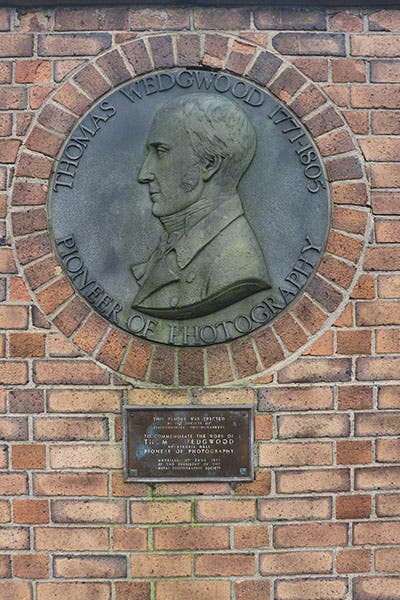Scientist of the Day - Thomas Wedgwood
Thomas Wedgwood, an English chemist, was born May 14, 1771. Thomas was the son of Josiah Wedgwood I, the founder of the Wedgwood pottery firm, and the younger brother of Susannah Wedgwood, Charles Darwin’s mother, and Josiah Wedgwood II, Darwin’s uncle. Thomas has a good claim for having invented the technique of photography, forty years before Louis Daguerre and William Fox Talbot announced their techniques in 1839. Around 1800, Thomas discovered that if one placed an object, such as a leaf, on a piece of paper coated with silver nitrate, and then exposed it to sunlight, a detailed silhouette would appear on the paper. This discovery was announced in the Journal of the Royal Institution of Great Britain in 1802, in a paper written by the young, up-and-coming Humphry Davy. The Journal of 1801-02 was an ephemeral affair, and lasted only one year, and we do not have it in our collections, so we cannot show you Davy’s paper. It was titled: “An Account of a Method of Copying Paintings upon Glass, and of Making Profiles, by the Agency of Light upon Nitrate of Silver. Invented by T.Wedgwood, Esq.” We do know that Wedgwood had not discovered any way to “fix” his images, so that unless kept in the dark, any original exposures would have darkened over time and the images would have been lost.
In April of 2008, Sotheby's was ready to auction off what was thought to be an early Talbot photograph, a silhouette of a leaf, with a “W” mark in the corner and some hard-to-read initials on the back (first image). They sought the opinion of a historian of photography, Larry Schaaf, who said that it was certainly not a Talbot, and proposed other possibilities, including that the ”W” might stand for Wedgwood, and this might be an original Wedgwood photogram, as such shadow exposures are called. If so, it would be the oldest surviving photograph in the world. Sotheby’s printed Schaaf’s remarks right in the catalog and listed the leaf as by an “unknown photographer.” However, newspapers around the world jumped to the conclusion that this was an original Wedgwood photogram, and front-page stories ran everywhere about the world’s oldest photograph, often with a portrait of Wedgwood next to the “The Leaf.” Sotheby’s was at first delighted, since the bidding was likely to be astronomical, but eventually they withdrew “The Leaf” for further examination by experts. (“The Leaf” is sometimes referred to as the “Quillan Leaf,” from the name of the person who put together the collection that Sotheby’s was auctioning, but I do not like the practice of naming objects after collectors and prefer not to use it).
It wasn’t until 2015 that Schaaf figured out that the “W” was the mark of William West, who made photographic paper, and the initials on the back were “S.A.B,” which stood for Sarah Anne Bright, the daughter of Henry Bright, from whose album “The Leaf” had come. So now “The Leaf” is heralded as the oldest surviving photograph taken by a woman, probably in 1839, and Wedgwood is back where he started, still the inventor of photography, but with no physical legacy equivalent to “The Leaf.” Where “The Leaf” is right now, I could not discover.
Wedgwood developed his photographic technique while being treated for consumption at Thomas Beddoes’s Pneumatic Institution of Bristol (which is where he met Humphry Davy). Sadly, as was the case with nearly all such patients in those days, Wedgwood lost his battle with tuberculosis, dying in 1805 at the age of 34, four years before his would-be nephew, Charles Darwin, came into the world. There is a fine ceramic portrait of Wedgwood set in brick at the Etruria pottery works in Staffordshire. We show both the portrait (second image) and the entire memorial in Stoke-on-Kent (third image).
Since today’s post is essentially a series of asides and digressions, I see no reason why we cannot include one more. William West, who made the photographic paper that recorded “The Leaf,” had earlier acquired a former mill in Bristol in which he installed telescopes to turn it into a public observatory, Clifton Observatory. At the top, he installed a lens that projected an image of the surrounding landscape down into a dark room below. It was a camera obscura, and it opened to the public in 1836. It is still there, and still open to the public, one of only three such in all of England, where you can view a 360° panorama of Bristol. A flyer of 1842 advertised the tourist attraction (fourth image) and a recent photo (fifth image) shows the Observatory, at the right, with the camera obscura, and the Clifton Suspension Bridge over the River Avon just behind, designed by Isambard Kingdom Brunel and completed after his death in 1864. The camera must provide quite a view of the bridge and the River Avon Gorge.
William B. Ashworth, Jr., Consultant for the History of Science, Linda Hall Library and Associate Professor emeritus, Department of History, University of Missouri-Kansas City. Comments or corrections are welcome; please direct to ashworthw@umkc.edu.





![Flyer advertising the camera obscura in Clifton Observatory, Bristol, and mentioning “Mr. [William] West” by name (Wikimedia commons)](https://assets-us-01.kc-usercontent.com:443/9dd25524-761a-000d-d79f-86a5086d4774/8900674e-f775-490f-9ec1-058bb7efd9a5/wedgwood4.jpg?w=359&h=600&auto=format&q=75&fit=crop)





